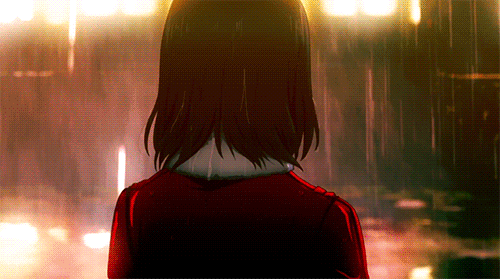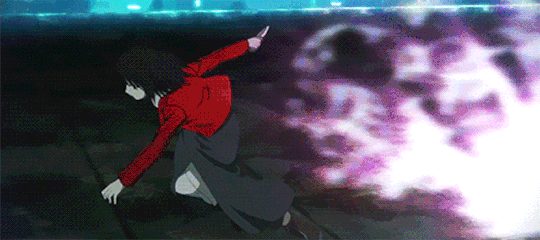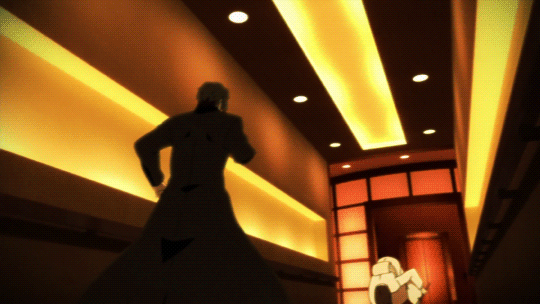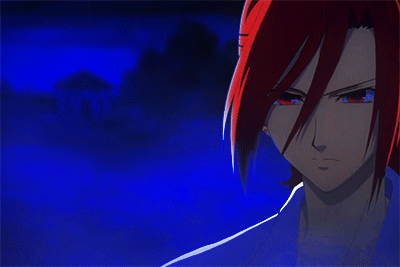originally posted at https://canmom.tumblr.com/post/714508...
We are entering… a slightly tricky phase of Animation Night. It’s not that we’re out of great animated films, far from it. Hell, we’ve yet to screen such classics as The End of Evangelion or Adolescence of Utena. But that’s the puzzle: a lot of such films are awkward fits for the format, requiring a lot of context, or standing too short or too long to fill the format.
Nor are we short of beautiful, artistic films from Europe. AniObsessive recently did a column on The Swallows of Kabul, which might finally be an answer the question of ‘what the hell could go beside Funan’. But I think we’ve had a bit too much war and genocide on this blog lately, so we’ll save that for another day.
Instead, let’s keep it chuuni!
It’s been a long while since Animation Night had anything to do with the Nasuverse. Back on Animation Night 60, I wrote a fairly brief description of Fate, and we enjoyed the spectacular Heaven’s Feel movies with only mild confusion.
But this was far from the only time that studio Ufotable adapted the the works of the enigmatic king of chuunibyou, Kinoko Nasu.

Let’s set the scene to begin. I’ll try and go over what I’ve been able to find out about the history, bearing in mind that Nasu-san is insanely prolific and his meta-setting is a seemingly infinite rabbit hole of lore…
…but as far as the man* himself there’s only the barest information to go on about his earlier life. He went to Hosei University, and afterwards started creating novels with his high-school buddy Takashi Takeuchi. Their first project was 空の境界 Kara no Kyōkai, lit. The Boundary of Emptiness but titled in English The Garden of Sinners in 1998 - that’s our subject for tonight, so more on that in a minute!
(*Wikipedia offers a citation for ‘man’ to a 2004 blog post where he jokes about being called a girl in a newspaper, in which he remarks もともと女々しいのがワタクシの芸風ですものボンソワー。[My style’s always been feminine, bonsoir.]; no further comment on that.)
In 2000 the pair founded a dōjin circle called TYPE-MOON to publish the visual novel 月姫 (lit. Moon Princess), which was a mega-hit when it launched at Comiket, and from that went on to create another visual novel called Fate/Stay Night, which was an even bigger mega-hit. This led to a forest of spinoffs with increasingly baroque titles like ‘Fate/hollow ataraxia’ or ‘Fate/kaleid liner Prisma Illya’, the most successful being the gacha game Fate/Grand Order, which launched in 2015. That gacha game has in turn spawned many many adaptations of its various storylines, such as (deep breath) Fate/Grand Order - Absolute Demonic Front: Babylonia or Fate/Grand Order: Final Singularity - Grand Temple of Time: Solomon. Really rivaling Kingdom Hearts there. Some of these films have been described as creative and ambitious, others very staid and playing it safe, but to be honest I am a foreigner in this land and I can’t tell you too much about them.
Anyway, as far as biographical details go, perhaps there’s more buried in an interview somewhere? But if so, I’ve yet to find it.

Our subject for tonight is a seven movie series produced by Ufotable from 2007-9, adapting Nasu’s first work. You might say, Bryn, that’s nuts, seven entire movies! To clarify, these movies are for the most really short, each just about an hour long with a couple of exceptions. So we should be able to pretty comfortably view the whole thing over two Animation Nights.
So what’s it about?
Set when it was written in the late 90s, it follows a teenage girl demon hunter called Shiki Ryougi, who has ‘Mystic Eyes of Death Perception’, which let her see indications of how things will die. She becomes a detective specialising in supernatural cases, alongside her eventual husband, Mikiya Kokutou. So romance and supernatural battles.
Many of these ideas, particularly the death perceiving eyes, would be reprised in Tsukihime. Within the meta-narrative, Kara no Kyōkai is an alternate universe, but not one completely disconnected from the rest, with its characters showing up for minor roles - and even playing a role in the end of Heaven’s Feel.
Except, that’s selling it short, because it’s also the first outing for the more esoteric concepts of the Nasu’s works: the Akashic Record, the Jungian anima and animus, and the paradoxes of the Taiji in Chinese philosophy to name a few. And to ground that, all sorts of dark shit: Wikipedia reels of suicide, rape, patricide, incest and murder, along with DID. It sounds like a lot!
Of course, it’s also about ridiculous psychic powers with long names, magic eyes, and so on. It’s easy to mock all these chuuni elements as hollow and pretentious, but imo the resulting blend is to strike out somewhere fascinatingly weird and achieve effects that a more reserved work couldn’t. We’ll see whether that comes together here!

In discussing the film series, Nasu described the original work - which he came to view as a rough early work - as ‘like a prose poem’, inherently very difficult to adapt. He turned down proposals to adapt it as a TV series and a movie, imagining it would be too hard for audiences to follow. But when a seven-movie series by Ufotable was proposed, he changed his mind:
It was such an off-the-wall idea that I got caught up in the enthusiasm; the offer was so awesome that turning it down seemed rude, so I agreed readily.
So, that’s one of the two characters in our story. What of the other?
Ufotable would later make ‘adapting Fate works’ into a steady line of work alongside popular shōnen like Demon Slayer. But at this time, they were a much more experimental studio. At sakugablog, kVin writes…
[Aniplex producer Atsuhiro] Iwakami had been ruminating about how to put together an adaptation for Kara no Kyoukai that actually lived up to the potential he saw in Kinoko Nasu’s world since 2004, and by the following year, the solution to his woes manifested in front of his eyes. Futakoi Alternative was an eccentric reboot of a milquetoast, twins-themed harem series. It reimagined everything about the original series into a simply indescribable mix of genres and crazy scenarios. The motto of ufotable’s founder Hikaru Kondo resonates throughout the whole series: if making as many things as possible is the way to ensure you’ll get some of them right, why not jump around from noir cinema, to sci-fi epics, then back to face some humanoid squids before some surprisingly earnest romance? For viewers like Iwakami, this irreverent spirit was a wake-up call about new ways to create animation. So, why not approach them when he was planning something grand that wasn’t quite like anything seen before in anime?
In fact, Iwakami’s original idea was merely a trilogy; it was Ufotable founder Hikaru Kondo who was like nah man let’s do seven. Within the studio were type-moon fans such as director Takuya Nonaka and character designer Tomonori Sudo, whose passion inspired Kondo to go big. Recklessly big. The initial plan was to release a new film monthly, but this soon proved predictably impossible. Even so, they managed to complete the series within two years, which is pretty astonishing in its own right.

As you can see from the clips in this post, the visual style of these movies anticipates - if perhaps in a cruder form - the studio’s later Fate adaptations: chiaroscuro lighting and gradients and filters on top of gradients and filters. Not everyone’s cup of tea, but as far as a house style goes, it’s worth acknowledging.
Internally, its direction was shaped by the flatter-than-usual hierarchy of Ufotable (whose name refers to a round table in the Arthurian sense). Each movie was assigned a different director without a structure unify the production as a whole beyond adherence to Nasu’s work.
I’ll pull in kVin to describe the resulting vibe of the project:
At its core, Kara no Kyoukai is a pretty cute love story that asks itself whether it’s possible to stray away from your fate; to put it plainly, Kokutou claims that he can fix her, even if the fixing involves getting over a pesky character flaw such as a predisposition towards murder. While not a groundbreaking scenario, its commitment to that relationship in spite of all the extraneous elements makes it work, and Shiki in particular is a slaughterer with very charming body language that evolves according to the major shifts to her character.
At the same time, these films are also highly atmospheric and committed to the sensorial experience in a way that no other Type-Moon anime is. While the expository worldbuilding and dense dialogue that Nasuverse works are known for are still very much present, the Kara no Kyoukai films are also willing to stay silent for minutes at a time. The mystery aspect to these films—Shiki and Kokutou work for Aozaki Touko’s detective agency after all—is honored with an appreciation for the mystique; even if you know that long-winded answers are likely to come, they tend to relish the opportunity to soak the viewer in the grim, mysterious atmosphere of its world. There is a quiet appreciation of the things that are yet to be known, and those that may not be spelled out.

At the time, he writes, the staff were intimidated by the idea of theatrical animation, which in the 90s called to mind Patlabor and Satoshi Kon - a tough act to follow, no question. But the dense image boards of art director Nobutaka Ike, who worked on those very same films, brought the confidence needed.
The films follow the same release order as the original novels, which is narratively non-chronological.
Nasu, for his part (link again), was anxious about his early works being adapted…
In Kara no Kyoukai, the first story, “Overlooking View” (俯瞰風景) is the clumsiest. I’ve always thought I wanted to do something about it, and I told a staff member, “If we’re making this into a movie, I’m going to rewrite the first story; please let me do that.” But he said, enthusiastically, “No, I want to work with it the way it is. I want to animate this!”
Then, when I read the finished script, they’d cut out over half of the unnecessary excess fat and had turned out something more interesting as a story, so I thought, “If it’s like this, they don’t need me to rewrite it.”
In Nasu’s view, each film ought to stand alone, but the full picture can’t really be understood from just the first - but he claims that with all seven films, the viewer would have enough to understand the story without having to turn to the books. Which is lucky, because the only version of the books in English is a widely disparaged fan translation.
To support all this comes haunting music by composer Yuki Kajiura and her group Kalafina, who would later create the renowned soundtrack to Madoka. In fact these movies are the origin of Kalafina, with Kajiura putting together a new group with a couple of members of her previous project FictionJunction.
Anyway, please read the rest of kVin’s article (perhaps after the movies! x3) if you fancy a detailed retrospective on all seven films.
Tonight my plan is to screen the first four parts of The Garden of Sinners, namely…
- I: Overlooking View - an introduction to the series. In 1998, Shiki lives alone in her apartment, occasionally visited by Mikiya, and working for an occult detective agency. She learns of a series of strange suicides at an abandoned building. Investigating, she finds the building is full of hostile ghosts. Someone is drawing the girls to the building by astral projection…
- II: A Study in Murder - Part 1 - in 1995, Shiki and Mikiya are highschool students. A spree of brutal murders break out in the area. Mikiya discovers that Shiki (式) is plural, with a male alter called SHIKI (織) who is the inverse of her personality. But who’s doing the murders?
- III: Remaining Sense of Pain - A teenage girl called Fujino is raped by a group of gangsters, and pursues revenge with her psychic powers. Shiki and Mikiya are pulled in to the case, and realise that Shiki once knew Fujino - a girl who could not feel pain. But that seems to have changed…
- IV: Hollow Shrine - a direct sequel to the second film. Shiki ended up comatose, and now in the psychic void, confronts her alter. We learn about her backstory and how she got involved with the wizard detectives.
I think these summaries should convey the level of Content™ we’re dealing with here. Guards up!
Next time around, we’ll pick up with Paradox Spiral, Oblivion Recording, and then at last A Study in Murder - Part 2. Which will actually be longer, because PS and ASiM2 are two hours long. (There’s also an eighth movie, released in 2013, titled Future Gospel which is a new sequel written by Nasu for movie form.)
I think that will suffice for an introduction. Animation Night will be going live 7:30 UK time, about 40 minutes from this post, and at 8pm UK time we shall begin the movies! Join me at https://www.twitch.tv/canmom~
Comments
Kream
What tha helllllll